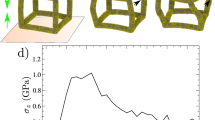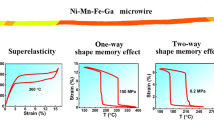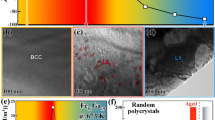Abstract
The magnetic shape-memory alloy Ni–Mn–Ga shows, in monocrystalline form, a reversible magnetic-field-induced strain (MFIS) up to 10%. This strain, which is produced by twin boundaries moving solely by internal stresses generated by magnetic anisotropy energy1,2,3,4, can be used in actuators, sensors and energy-harvesting devices5,6,7. Compared with monocrystalline Ni–Mn–Ga, fine-grained Ni–Mn–Ga is much easier to process but shows near-zero MFIS because twin boundary motion is inhibited by constraints imposed by grain boundaries8,9,10. Recently, we showed that partial removal of these constraints, by introducing pores with sizes similar to grains, resulted in MFIS values of 0.12% in polycrystalline Ni–Mn–Ga foams11, close to those of the best commercial magnetostrictive materials. Here, we demonstrate that introducing pores smaller than the grain size further reduces constraints and markedly increases MFIS to 2.0–8.7%. These strains, which remain stable over >200,000 cycles, are much larger than those of any polycrystalline, active material.
This is a preview of subscription content, access via your institution
Access options
Subscribe to this journal
Receive 12 print issues and online access
$259.00 per year
only $21.58 per issue
Buy this article
- Purchase on Springer Link
- Instant access to full article PDF
Prices may be subject to local taxes which are calculated during checkout



Similar content being viewed by others
References
Ullakko, K., Huang, J. K., Kantner, C., O’Handley, R. C. & Kokorin, V. V. Large magnetic-field-induced strains in Ni2MnGa single crystals. Appl. Phys. Lett. 69, 1966–1968 (1996).
James, R. D. & Wuttig, M. Magnetostriction of martensite. Phil. Mag. A 77, 1273–1299 (1998).
Murray, S. J. et al. Large field induced strain in single crystalline Ni–Mn–Ga ferromagnetic shape memory alloy. J. Appl. Phys. 87, 5774–5776 (2000).
Müllner, P., Chernenko, V. A., Wollgarten, M. & Kostorz, G. Large cyclic deformation of a Ni–Mn–Ga shape memory alloy induced by magnetic fields. J. Appl. Phys. 92, 6708–6713 (2002).
Suorsa, I., Tellinen, J., Ullakko, K. & Pagounis, E. Voltage generation induced by mechanical straining in magnetic shape memory materials. J. Appl. Phys. 95, 8054–8058 (2004).
Sarawate, N. & Dapino, M. Experimental characterization of the sensor effect in ferromagnetic shape memory Ni–Mn–Ga. Appl. Phys. Lett. 88, 121923 (2006).
Karaman, I., Basaran, B., Karaca, H. E., Karsilayan, A. I. & Chumlyakov, Y. I. Energy harvesting using martensite variant reorientation mechanism in a NiMnGa magnetic shape memory alloy. Appl. Phys. Lett. 90, 172505 (2007).
Gaitzsch, U., Roth, S., Rellinghaus, B. & Schultz, L. Adjusting the crystal structure of NiMnGa shape memory ferromagnets. J. Magn. Magn. Mater. 305, 275–277 (2006).
Gaitzsch, U., Pötschke, M., Roth, S., Rellinghaus, B. & Schultz, L. Mechanical training of polycrystalline 7M Ni50Mn30Ga20 magnetic shape memory alloy. Scr. Mater. 57, 493–495 (2007).
Pötschke, M., Gaitzsch, U., Roth, S., Rellinghaus, B. & Schultz, L. Preparation of melt textured Ni–Mn–Ga. J. Magn. Magn. Mater. 316, 383–385 (2007).
Boonyongmaneerat, Y., Chmielus, M., Dunand, D. C. & Müllner, P. Increasing magnetoplasticity in polycrystalline Ni–Mn–Ga by reducing internal constraints through porosity. Phys. Rev. Lett. 99, 247201 (2007).
Müllner, P., Chernenko, V. A. & Kostorz, G. Large cyclic magnetic-field-induced deformation in orthorhombic (14M) Ni–Mn–Ga martensite. J. Appl. Phys. 95, 1531–1536 (2004).
Sozinov, A., Likhachev, A. A., Lanska, N. & Ullakko, K. Giant magnetic-field-induced strain in NiMnGa seven-layered martensitic phase. Appl. Phys. Lett. 80, 1746–1746 (2002).
Chmielus, M., Chernenko, V. A., Knowlton, W. B., Kostorz, G. & Müllner, P. Training, constraints, and high-cycle magneto-mechanical properties of Ni–Mn–Ga magnetic shape-memory alloys. Eur. Phys. J. Special Topics 158, 79–85 (2008).
Marioni, M. A., O’Handley, R. C. & Allen, S. M. Pulsed magnetic field-induced actuation of Ni–Mn–Ga single crystals. Appl. Phys. Lett. 83, 3966–3968 (2003).
Lázpita, P., Rojo, G., Gutiérrez, J., Barandiaran, J. M. & O’Handley, R. C. Correlation between magnetization and deformation in a NiMnGa shape memory alloy polycrystalline ribbon. Sensor Lett. 5, 65–68 (2007).
Gaitzsch, U., Pötschke, M., Roth, S., Rellinghaus, B. & Schultz, L. A. 1% magnetostrain in polycrystalline 5M Ni–Mn–Ga. Acta Mater. 57, 365–370 (2009).
Gaitzsch, U., Techapiensancharoenkij, R., Pötschke, M., Roth, S. & Schultz, L. Acoustic assisted magnetic field induced strain in 5M Ni–Mn–Ga polycrystals. IEEE Trans. Magn. 45, 1919–1921 (2009).
Gschneidner, K. A. Jr & Pecharsky, V. K. Recent developments in magnetocaloric materials. Rep. Prog. Phys. 68, 1479–1539 (2005).
Segui, C. et al. Low temperature-induced intermartensitic phase transformations in Ni–Mn–Ga single crystals. Acta Mater. 53, 111–120 (2005).
Hathaway, K. & Clark, A. E. Magnetostrictive materials. MRS Bull. 18, 34–41 (1993).
Acknowledgements
The authors thank A. Rothenbühler (Boise State University) for assistance with magnetic and magneto-mechanical experiments. This project was financially supported by the National Science Foundation through grant NSF-DMR 0804984 (Boise State University) and DMR-805064 (Northwestern University). M.C. acknowledges partial financial support through the German Research Foundation (DFG) priority program SPP 1239 (grant No. Schn 1106/1). P.M. is grateful to ETH Zürich for donating magneto-mechanical testing devices.
Author information
Authors and Affiliations
Contributions
X.X.Z. produced the foam and characterized its architecture, twin microstructure and porosity. M.C. and C.W. carried out the magnetic and magneto-mechanical experiments. M.C. analysed the data and wrote the first version of the manuscript, with contributions from X.X.Z. P.M. and D.C.D. conceived the dual-porosity strategy, supervised the experiments at their respective universities and completed the manuscript.
Corresponding author
Supplementary information
Supplementary Information
Supplementary Information (PDF 1398 kb)
Rights and permissions
About this article
Cite this article
Chmielus, M., Zhang, X., Witherspoon, C. et al. Giant magnetic-field-induced strains in polycrystalline Ni–Mn–Ga foams. Nature Mater 8, 863–866 (2009). https://doi.org/10.1038/nmat2527
Received:
Accepted:
Published:
Issue Date:
DOI: https://doi.org/10.1038/nmat2527
This article is cited by
-
Framework of magnetostrain responsive Ni–Mn–Ga microparticles driving magnetic field induced out-of-plane actuation of laminate composite
Scientific Reports (2023)
-
Strain-magnetization property of Ni-Mn-Ga (Co, Cu) microwires
Rare Metals (2023)
-
Ferroelastic oligocrystalline microwire with unprecedented high-temperature superelastic and shape memory effects
NPG Asia Materials (2022)
-
Heterostrain-enabled ultrahigh electrostrain in lead-free piezoelectric
Nature Communications (2022)
-
Mechanical response during bending of Ni–Mn–Ga-based melt-spun ribbons
Journal of Materials Science (2022)



